The Influence of Europe on Colonial Massachusetts Medicine*
EUROPEAN medicine had already had an influence on the region that the Pilgrim Fathers colonized in 1620, and which, from 1691, was to be merged with the colony of Massachusetts. In 1603 Captain Martin Pring had explored the region looking for sassafras, first introduced by the Spaniards into Europe from Florida and much used for the treatment of syphilis, rheumatism, and dropsy. Subsequent contact between Europeans and the indigenous Indians led to “a prodigious Pestilence as carried off not a Tenth, but Nine Parts of Ten (yea ’tis said Nineteen of Twenty) among them; So that the Woods were almost cleared of those pernicious Creatures, to make room for a better Growth.”1
It is, of course, correct to speak of European rather than English medicine, for Europe had a common medical tradition based, as it all was, on the writings of classical medical authors and maintained by the circulation of printed works and the policy of the great medical universities of accepting students from all countries. National differences existed, however, in the organization and control of medical services.
Except possibly for Samuel Fuller, the Pilgrims had in their number no trained medical men. They were in this no worse off than many English rural communities that had to depend on oral tradition, herbals, and popular medical works to deal with their ills.
The New England Company for a Plantation in Massachusetts Bay, formed to take over the assets of the failed Dorchester Company of Adventurers, realized the importance of medical services, and one of their first acts was to send to the colony in 1628 the surgeons John Pratt and Robert Morly. And, appreciating that the settlement could not depend on a perpetual supply of English-trained doctors, the following year they sent out, on a three-year contract, Lambert Wilson, part of whose job was to train in surgery two or three local young men.2
Though Plymouth was founded by religious refugees, and the organization of the settlement was conditioned by Puritan faith and hope, its development was hindered by the slender resources of the settlers. It was the Massachusetts Bay Company, under which name the New England Company had received its royal charter, founded by men of wealth, education, and influence, that, in 1630, sent out John Winthrop as governor with some thousand emigrants to establish in Massachusetts a great Puritan state, founded not only on reformed religion but also on reformed social organization.
Religious reformation in the sixteenth century had led some Europeans to consider other areas of thought and work in need of reformation, in particular education and the professions. Though little was published in England on those topics till after 1640, when censorship broke down, some of the highly educated men who emigrated with Winthrop must have known the writings of such men as Erasmus, Rabelais, Sir Thomas Elyot, and Ramus, and later of Comenius, all of whom criticized contemporary educational systems and the domination in the schools of Latin grammar, calling for a much wider curriculum in both schools and universities. They were certainly acquainted with the writings of Francis Bacon, for his books were in many early Massachusetts libraries. Bacon held that reformed education would lead to the advancement of learning and this, in turn, to the Great Instauration, for he said: “Man by the Fall fell at the same time from his state of innocency and from his domination over creation. Both these losses however can even in this life be in some part repaired; the former by religion and faith, the latter by arts and science.”3
Of the “arts and science” medicine formed a most important part, for in the Great Instauration of man to his state before the Fall, not only was a healthy body a precondition of spiritual health, but also the restoration of man’s domination over creation included his domination over the ills of the body. This would be achieved through God’s help by man’s discovery of the secrets of health and sickness. The causes of sickness once known, they could be avoided or cured, and man would have restored to him his immortality, or at least a life span of a thousand years.4
Massachusetts did not lack religion and faith, and after they had “builded our houses, provided necessaries for our livelihood, rear’d convenient places for Gods worship and setled the Civill Government: one of the next things we longed for, and looked after was to advance Learning and perpetuate it to Posterity.”5
From 1635 onwards schools were founded in the main towns and universal education was aimed at, but, surprisingly, the curriculum of the Latin schools showed no improvement on the existing English grammar schools.
The institute of higher education, later to be called Harvard College, was founded in 1636. The course of studies, which began there in 1638, was based on the teaching at the university and colleges of Cambridge which, maintaining the primacy of Latin and Greek, fell short of the ideals of the reformers. And at Harvard change was to come slowly. President Leonard Hoar, a Cambridge M.D., who attempted to introduce practical subjects into the curriculum was, in 1675, forced to resign.
English Puritan commitment to educational reform was demonstrated in the enlightened curricula, including science and modern subjects, of the dissenting academies, established to provide higher education for dissenters excluded from Oxford and Cambridge by the Act of Uniformity of 1662. Charles Morton, founder of one of the earliest academies at Newington Green, in 1685 emigrated to Massachusetts and became vice president of Harvard, but the only innovation he introduced was the use of his manuscript natural philosophy text, Compendium physicae.6 His attempts to provide private tuition were frustrated by Harvard College.7
Harvard lagged behind English universities in the introduction of science teaching. It was not till a later John Winthrop was appointed Hollis Professor of Mathematics and Natural Philosophy in 1738 that physical sciences made any appreciable contribution to the curriculum, and neither chemistry nor botany was taught there during the colonial period.
Not only did Harvard teach little of the sciences basic for medicine; it differed from Cambridge in providing no medical education at all during the whole colonial period. This is surprising, considering the high priority given to medicine by English Puritan reformers. Further, while only two professional medical men emigrated with John Winthrop, some of the clergy who came with him or joined him soon afterwards had, like other of their brethren in England, “on a foresight of a ruin of the clergy,” availed themselves of the medical education at Oxford or Cambridge or had studied it privately for an alternative profession, and these medical ministers were the mainstay of the medical services in the small communities of the colony, too poor to support both minister and doctor. Moreover, Puritan thought, as expressed by Gabriel Platte in his utopian Macaria, would have “the parson of each parish a good physician, and doth execute both functions, to wit cura animarum & cura corporum,” which Charles Chauncey, President of Harvard (1654–1672), firmly agreed with. Yet Harvard left the individual to train himself in medical matters. One wonders if better provision would have been made if the Swedish ambassador to Holland had not seduced Amos Comenius, the Czech educational philosopher, from honoring his commitment to John Winthrop, Jr., in 1642 to come to Massachusetts and take over the presidency of Harvard. The most influential educational reformer of the day, Comenius advocated universal education in universal colleges in which would be taught universal knowledge, including medicine.8
Not only did Harvard provide no medical teaching, it provided virtually nothing by which students could help themselves to medical knowledge. In 1723, after nearly one hundred years of existence, its library contained none of the great works of European medicine of the seventeenth and early eighteenth centuries, not even those published in England, Harvey’s De motu cordis, the works of Sydenham, Glisson, or Willis, or any modern work on surgery. Indeed, the only anatomy text at Harvard was the 1602 edition of Andre Du Lauren’s Anatomy, an edition without illustrations, supplemented by Nicholas Culpeper’s translation of Riolan’s Sure Guide to Physic and Chyrurgy, which had a few anatomical plates.9 But Harvard must not be blamed; because the college could not afford to purchase books, its library was built up by gifts. President Dunster, aware of its shortcomings, petitioned the Commissioners of the United Colonies in 1647 for books on various subjects, including physic, but the request met with no response.
After 1723 there was a great improvement, for when the library was burnt in 1764 it lost “a collection of the most approved medical Authors.”10 Dr. Richard Mead, the famous London doctor, presented copies of his works in 1726 and again in 1748. William James of Jamaica, in 1752, gave medical books and £25 for the purchase of more, and in 1758 Dr. Hales sent twenty-nine volumes of the works of his father, Dr. Stephen Hales. And the university by this time possessed not only books, but two skeletons, a microscope, and Albinus’s anatomical tables given by local inhabitants.11 After the fire local doctors gave books and money, as did individuals and societies in Britain, to help rebuild the library, and Chief Justice Andrew Oliver arranged for his son Peter, studying medicine in London, to procure anatomical preparations for the College.12
What was lacking in the Harvard library could often be found in private libraries, particularly those of such men as John Winthrop, Jr.,13 and the Mathers.14 By 1670 a bookshop had been established in Boston, and by 1686 a number were in existence, importing books from Europe. At least one was dealing in medical books and, increasingly, they became part of the stock-in-trade of most booksellers.15 Silvester Gardiner, a Boston physician who kept an apothecary shop, combined with it a medical bookstore, for there is in the manuscript collection at the Countway Library an invoice dated 1755 from Innys and Richardson, London, for multiple copies of some thirty recently published medical books supplied to Gardiner, ranging from twelve copies of Richard Brookes’s Introduction to physic (1754) to one copy of the translation of Winslow’s Anatomy (1733).16 It has not been possible to discover how common it was for apothecary shops to sell medical books.
Even medical apprentices were using the most recent medical texts, or at least Silvester Gardiner’s were. John Hartshorn left a diary of his apprenticeship with Gardiner in which he recorded not only what he ate but also what he read. During the three years starting in 1752 he read, at least in part, some eighty books, all recently published, but he died before completing his apprenticeship, partly, one fears, from indigestion both physical and mental.17 But even Samuel Adams, Jr., apprenticed to Dr. Freeman at Sandwich, was, in 1769, reading Whytt’s Observations on Nervous diseases (1767) and van Swieten’s Commentaries on Boerhaave, which were being published at that time.18
The first medical work published in Massachusetts, Thomas Thacher’s A brief guide to the Common people of New England how to order themselves in the Smallpox or measles, 1678, was based on an English book by Thomas Sydenham. During the colonial period some sixteen British medical works were republished in Massachusetts,19 mainly pamphlets relating to inoculation for smallpox, and popular works like John Theobald’s Everyman his own physician (1768), likely to have a wide sale rather than specialist texts, the demand for which would be limited and which arrived rapidly in the colony anyway. Not only was the colony dependent on Europe for medical texts, it also imported the bulk of its drugs and surgical instruments and even such items as wooden legs.20
But books were not the only way that European medical ideas reached Massachusetts. Though few academically trained men emigrated to the colony, of these one or two, like William Douglass, played an important part in the history of medicine in Massachusetts. Naval and merchant ships and the army often brought to seaports and army camps doctors who had just qualified and could report on medical developments at home.
But, from the beginning, young men of wealthy parents, ambitious of obtaining the best medical education, traveled to Europe to obtain it. It is impossible to make a full and accurate list of such students, but between 1630 and 1775 at least forty-six men from the colony studied medicine abroad. Between 1630 and 1700 eight studied in Leyden, Padua, or London, and one of them obtained, in 1654, the first medical degree awarded by King’s College, Aberdeen. Between 1700 and 1775 twenty-three studied in London, of whom three obtained medical degrees on application to Aberdeen. Six studied at Edinburgh, of whom two obtained M.D.s, and one studied somewhere “in Europe.” Of those studying in London two also spent time in Paris and one in Edinburgh, and of the Edinburgh men two spent time in London and Paris.21 Others, like Zabdiel Boylston, though trained in the colony, utilized visits to England to broaden their medical knowledge and surgical techniques.
This pattern of foreign medical education differs markedly from that in the southern American colonies and also from that in Pennsylvania. For South Carolinians and Virginians tended to study only at Edinburgh, while Pennsylvanians often studied both in London and at Edinburgh.
The education provided in London was predominantly practical, based on anatomy, with opportunities for dissecting, work in the hospitals learning surgical techniques and accompanying the physicians on their rounds of the wards, and in gaining experience in midwifery. At Edinburgh the courses were much more academic, concentrating on medical theory.
Why was it, then, that Massachusetts tended to choose practical medicine, the southern colonies theoretical medicine and the Pennsylvanians an all-round medical education? Or was it more a matter of choice forced on them by circumstances? South Carolina and Virginia received many Scottish emigrants, particularly after the Jacobite rebellions in 1715 and 1745, including a number of Edinburgh-trained doctors who would have recommended their alma mater to medical students of their acquaintance. The tobacco trade intensified the connection between Virginians and Scotland. A fair percentage of South Carolinians and Virginians going to Edinburgh were the sons or grandsons of Scottish emigrants and had Scottish relatives and friends. For Pennsylvanians a somewhat different situation existed. Some medical students went to London with introductions to John Fothergill, an influential Quaker doctor, who corresponded with a number of Pennsylvanian Quakers. Others had introductions to Benjamin Franklin, a friend of Fothergill, to whom he then recommended them. Fothergill, himself a graduate of Edinburgh, counseled time in London to obtain a good grounding in fundamentals before going to Edinburgh to learn the theoretical aspects of the subject. It was two Pennsylvanians, trained in this way, who established the first medical school in Philadelphia and sent many of their students to follow the same course of study as they themselves had pursued.
Massachusetts European trade was mainly with London, and it was there that parents could arrange for bills to be discounted to pay for their sons’ studies, and where relations and family friends were to be found. London-trained doctors were among the most prestigious medical men in the community, and aspiring students, particularly their apprentices, would desire a similar medical education.
One of the most successful of the colony’s doctors, William Clark, studied in London in 1731, as did two of his apprentices, Joshua Gee and James Lloyd. Gee died in London, but James Lloyd rose high in the profession; four of his apprentices also went on to study there. Of those who studied in Edinburgh, two, Williams Smibert and John Cuming, were the sons of Scottish emigrants. Thomas Bulfinch, Jr., appears to have been attracted there from London by the growing reputation of the school. Of the other three I have no information. For anyone who could not afford to study in Britain, sets of notes from the London and Edinburgh lectures circulated in the colony.
But perhaps there was some basic Massachusetts lack of interest in theoretical medicine which, through the colonial period, had little effect on practice, for the standard treatment, on whatever theory it was based, was to consist of, more or less, bleeding and purging with the use of a few specific drugs and chemicals.22 The one outstanding Massachusetts medical theorist of the period, Cotton Mather, failed to get a publisher for his great medical work, The Angel of Bethesda.23
Not all who trained in Europe returned to practice in Massachusetts, but the majority did, and, both by example and by training apprentices, handed on European medical traditions. But some who practiced in the colony had little benefit of a medical education of any sort.
In London the practice of medicine was restricted to those licensed by the Royal College of Physicians, while surgery and dispensing were controlled by the Barber Surgeons’ Company and the Apothecaries’ Company (though the Royal College of Physicians defined the spheres of activity of surgeons and apothecaries). In the provinces doctors were licensed by Oxford or Cambridge Universities or by diocesan bishops, though it was impossible to prevent some unlicensed people from practicing in rural areas. Undoubtedly, this system, particularly in London, though theoretically aimed at maintaining medical standards, created a monopoly in the supply of medical services. Since the days of Queen Elizabeth most people had viewed monopolies, in commerce, industry, or the professions, as placing enormous powers of oppression in the hands of the crown. Monopolies granted by royal charter, often to favorites or as a reward for services sought or rendered, forced up prices and restricted the availability of goods and sevices. Efforts to break monopolies came to a head during the Commonwealth, when the Royal College of Physicians came under heavy attack; although it survived, its restrictive practices were to be the center of controversy throughout most of the eighteenth century. In 1649 the General Court of Massachusetts attempted to regulate the medical profession by forbidding anyone to perform the office of practitioner “without the advice & consent of such as are skillful in the same art if such may be had, or at least the wisest & gravest then present,” but through the colonial period little governmental control was exercised over the practice of medicine.24
The English organization also served to divide the profession into physicians, surgeons, and apothecaries, frequently fighting each other as one profession accused the others of usurping its perogatives. In Massachusetts, and in America in general, the necessary organizations being absent, there was no hindrance and every encouragement for the practitioners to engage in all three branches of medicine.
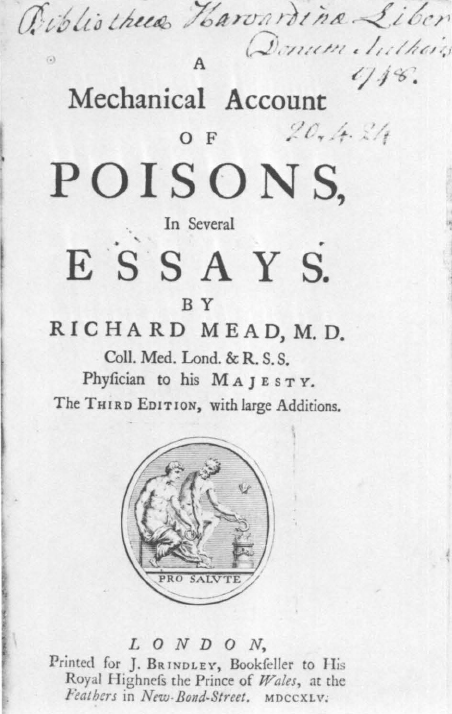
15. Title page of Richard Mead’s Poisons, given by him to Harvard College in 1748. Courtesy Boston Medical Library.
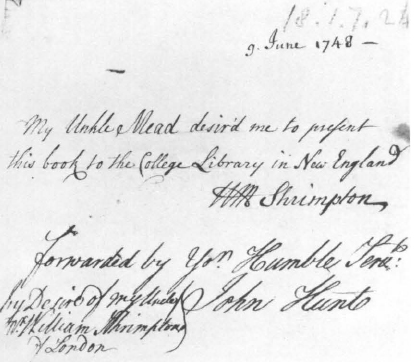
16. Inscriptions in the copy of Mead’s Poisons (see figure 15) that he gave to Harvard College in 1748. Courtesy Boston Medical Library.
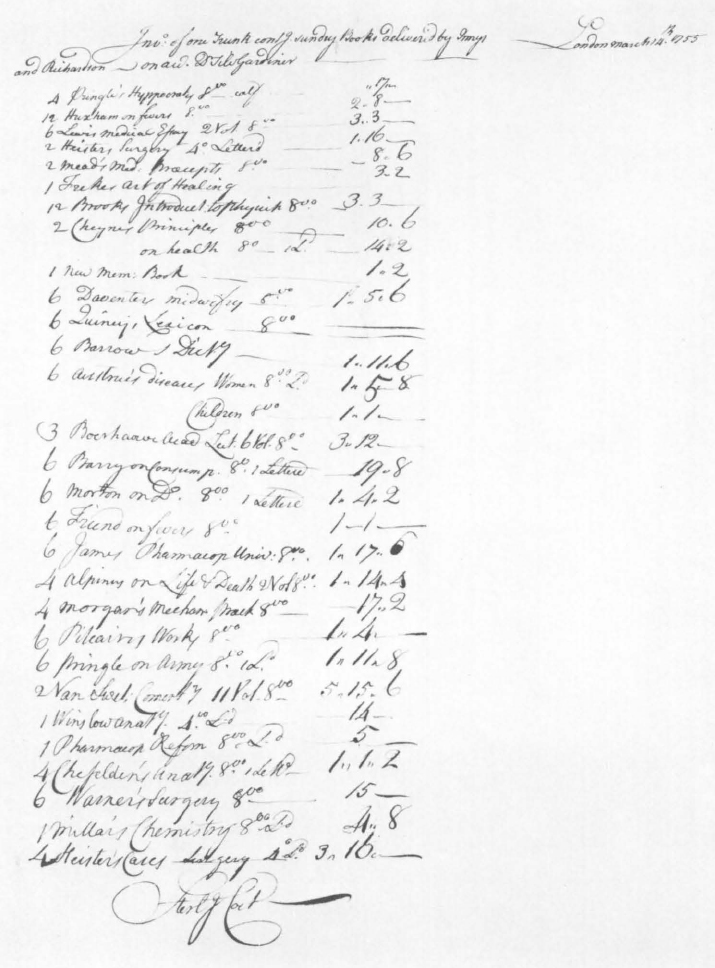
17. Invoice for medical books ordered from London by Dr. Silvester Gardiner in 1755. Because he ordered several copies of most works on the list, he probably intended to distribute some to his students and colleagues. Courtesy Boston Medical Library.
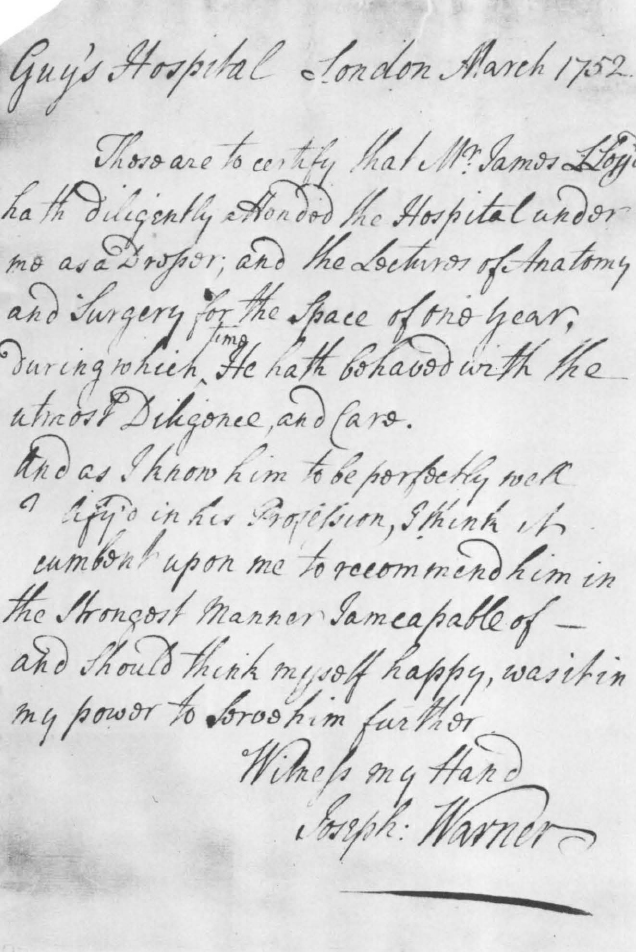
18. Certificate of attending hospital and lecture instruction issued to James Lloyd of Boston in March 1752 by Dr. Joseph Warner at Guy’s Hospital in London. Courtesy Boston Medical Library.
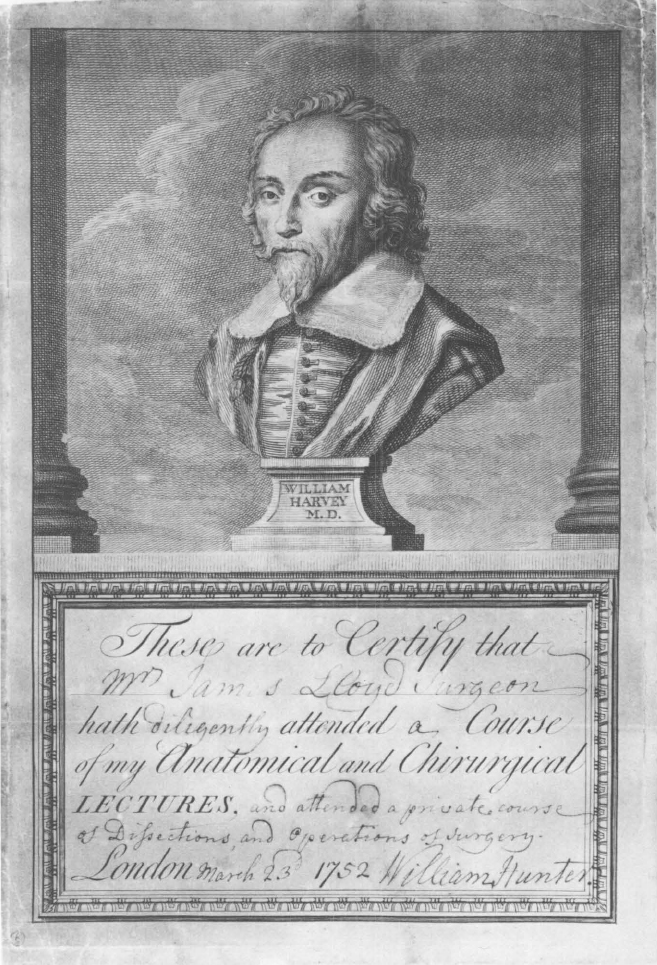
19. Dr. William Hunter certifies that “Mr. James Lloyd, surgeon, hath diligently attended a Course of my Anatomical and Chirurgical lectures, and attended a private course of Dissections, and Operations of Surgery,” 23 March 1752. Courtesy Boston Medical Library.
Up to the dissolution of the monasteries, the sick poor in England had been cared for in the hospitals of the religious houses. Henry VIII used some of the funds from the sale of monastic properties to endow the hospitals of three of the London foundations for the care of the city’s sick. But in the country generally the sick poor, through a series of acts passed in the sixteenth century, became the responsibility of the parish to which they belonged. How each parish responded to its responsibility depended on its circumstances. Some towns built almshouses or had them provided by benefactors for the care of their poor and sick. Some parishes were too poor to employ professional medical aid; some had locally no trained medical man to employ. A few, like Newcastle-on-Tyne, were sufficiently prosperous to employ a salaried “town’s physician.” There existed, under this system, a large amount of disease and distress for which no medical help was available.25
Good, free medical care of the sick poor had been an ideal of long standing. Large, airy hospitals for their care had been featured in Sir Thomas More’s Utopia (1516). The Puritans, so concerned with the health of the people, put forward schemes for providing comprehensive, preventive, and curative medical services, including hospitals staffed by salaried state officials. Though the establishment in Britain of anything approaching the Puritan scheme was some three hundred years in the future, at least a beginning was made during the Commonwealth in setting up the Hospital of the Savoy and Ely House to care for wounded soldiers, along the lines advocated by William Petty in Advice of W.P. to Mr. Hartlib (1646), in which not only was the organization of the ideal hospital described but also the part it should play in teaching and research. Unfortunately, the two hospitals that were moving towards undertaking their teaching obligations were abolished at the Restoration.26
By now, however, the importance of hospitals as caring and teaching institutions was generally recognized, and in the eighteenth century, up to 1775, five new London general hospitals and twenty-three in the provinces were founded, besides lying-in hospitals and dispensaries for the poor. But all these were the result of organized charity and were not state institutions.27
Massachusetts took over the English system of making local communities responsible for their sick poor, and this responsibility was met, as in England, according to the circumstances of the community. Where possible, local doctors were paid to look after the sick and destitute. At first concentrations of population were not sufficient to warrant the establishment of hospitals. Local householders were paid to take in those in need of care and nursing. As the population grew, almshouses were established in some towns, which, to a limited extent, functioned as hospitals, providing care for those inmates who were sick. But throughout the whole colonial period no general hospital was established in Massachusetts. This is surprising, considering the Puritan interest in hospitals, the lack of other facilities for medical teaching in the colony, and the facts that by 1743 the population of Boston had risen to about 16,382, much larger than that of English towns like York, Northampton, and Worcester that had had hospitals since the 1740’s, and that the populations of both Salem and Marblehead, by 1775, were no smaller than those of some English towns in which hospitals had been established.28 In England the hospitals provided care for some, at least, of those who, not destitute, were too poor to pay for medical services. In Massachusetts this class of poor depended on the goodwill of some members of the medical profession who either gave their medical services free or did not press for the payment of their bills.29
Between 1600 and 1775 medical theory had undergone fundamental changes. At the beginning of the seventeenth century it was based on the writings of Hippocrates, Galen, and other classical writers, and, though some cracks were appearing, the foundations still held. By 1775 the foundations of modern medicine were being laid. Massachusetts doctors who imported books, or who were trained in Europe, could keep abreast of new developments. Josiah Bartlett records:
Though the works of Hippocrates, Galen and Stahl and others were not unknown, those of Sydenham and his followers were principally studied by our older practitioners till the time of Boerhaave, whose invaluable labors commenced in 1701, which, with the comments of van Swieten, the practical writings of Whytt, Mead, Brooks, Huxham, the physiology of Haller, the anatomy of Cowper, Kiel, Douglas, Cheselden, Munro and Winslow, the surgery of Heister, Sharp, Le Dran and Pott, the midwifery of Smellie and Hunter and the materia medica of Lewis, were in general use at our political separation from the British Empire.30
One name, surprisingly, is missing, that of “that shining oracle of physic Dr. William Cullen of Edinburgh.” This omission may reflect the small number of Massachusetts men who had studied at Edinburgh; indeed, none but Swett had attended Cullen’s medical lectures, and Swett did not return to Massachusetts until 1778.
This represented the mainstream of medical thought. But there were some who embraced a more unorthodox approach to the subject. In the sixteenth century the medical theories of Paracelsus, particlarly his emphasis on chemical therapy placed within the framework of a whole set of ideas about man, nature, and God, had raised much controversy on the continent but little in England. However, after 1640, the apothecaries saw chemical therapy as a weapon with which to attack the Royal College of Physicians, who had forbidden apothecaries to prescribe medicines. They taunted the physicians with ignorance in refusing to consider chemical therapy, for which so much was claimed. But, further, because Paracelsian medicine was grounded in strong religious beliefs, it became of great interest to Puritan medical reformers, as a viable alternative to heathen Galenic medicine.31
Massachusetts had its advocates of Paracelsus’s chemical theories, known as iatrochemists. John Winthrop, Jr., had become interested in them before emigrating in 1631 to join his father, bringing with him a considerable library of iatrochemical works. He corresponded with European iatrochemists, and, during his subsequent visits to England, he strengthened these contacts. Although he is known to have prescribed chemical remedies, he was more interested in chemistry than in therapeutics, and his reputation in this field led to his election as a founder fellow of the Royal Society of London. His library was of use to other iatrochemists, such as Jonathan Brewer and George Starkey, who practiced chemical medicine for a time in Boston before going to London to join the group of iatrochemists centered round Samuel Hartlib.32
Paracelsian chemistry and medicine had a nonrational component and were allied with alchemy and hermetic beliefs. In England the iatrochemists came under increasing attack when chemical therapy was found to be no more effective against the Great London Plague of 1665 than was the traditional materia medica. Some chemicals, however, had proved effective and both in Britain and in Massachusetts continued to be used. Silvester Gardiner advertised in the Boston Gazette33 that he had just imported from London “all sorts of drugs and medicines both chemical and Galenical.” Adepts lingered on in Massachusetts as in Europe till well into the eighteenth century. Samuel Danforth, although he claimed to have discovered an elixir conferring eternal life, which he offered to Benjamin Franklin, died in 1777; his son, a London-trained doctor, continued his father’s interests.34
The colony of Massachusetts was founded just too early for its initial institutions to be influenced by the flood of reformist literature published in England after 1640. Judging from their libraries, the leaders of the Bay Colony were not ignorant of these writings, some of which were aimed at promoting the Great Instauration leading to the Millennium of God’s rule on earth. Nor were the men of Massachusetts less hopeful of the Millennium than their English brethren. However, it is not surprising, perhaps, from the forces that drove these men to emigrate, that the Massachusetts Puritans concerned themselves almost exclusively with promoting the Millennium through religion.35 Theoretically, Massachusetts would have been an ideal area in which to establish some of the social reforms, including those in education and medicine, advocated by the English Puritans. Besides the problems of finance and the lack of trained men that would have been necessary to develop comprehensive medical services, the strong religious bias of men dominant in the colony inclined them to the belief that illness, like other disasters, was God’s punishment for spiritual failure, and perhaps they thought prayer and repentance provided a better cure than doctors, and they had no interest in establishing in Massachusetts the first state medical service.
Puritan ideals faded as the colony grew and became more cosmopolitan, but there never developed the acute conditions of poverty, overcrowding, and malnutrition, with their attendant health hazards, that in European towns and cities provided much of the stimulus for the provision of hospitals and other services for their relief. Yet without control of the practice of medicine, without medical schools and hospitals as in Europe, and with much of the medical care provided through the goodwill of private individuals, the health of the colony was, in general, well cared for. Though the organization of medical services lagged behind that in Europe, the practice of medicine was dominated by European medical thought, though already America itself was beginning to play a part in the advancement of medical knowledge.
Acknowledgements I am more than grateful to Mr. Richard J. Wolfe, who brought to my attention manuscript material in the collections of the Francis A. Countway Medical Library, Boston. This material was a potent stimulus to my interest in Massachusetts colonial medicine. Dr. Philip Cash of Emmanuel College, Boston, most kindly provided me with information which otherwise I would not have been able to obtain. My thanks are also due to Dr. Harry C. Porter of Cambridge University and Dr. Alan Smith of Glasgow University both for advice and for necessary corrections.
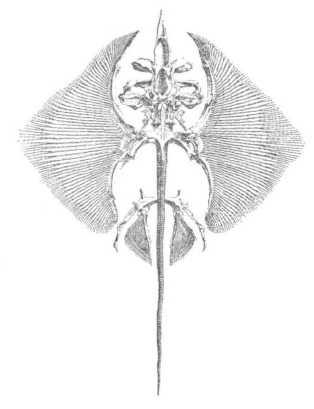
APPENDIX
A Biographical Register of Men and Women from and Immigrants to Massachusetts between 1620 and 1800 Who Received Some Medical Training in Europe
by C. H. Brock and Eric H. Christianson
We have attempted to compile an accurate and comprehensive list that will become a useful reference to researchers with many interests. Also, we have decided to include individuals whose primary purpose in traveling to Europe may not have been educational in nature. By not excluding these names, perhaps future researchers will be able to fill in the gaps in our knowledge about these people.

 C. HELEN BROCK
C. HELEN BROCK 